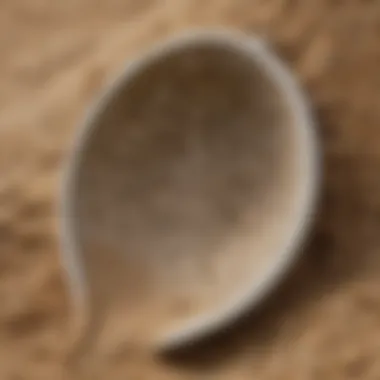Exploring the Utility and Mechanics of Beach Sand Scoops


Intro
Beach sand scoops are specialized tools used for a range of activities, from recreational beachcombing to professional treasure hunting. These devices are designed to sift through sand, allowing users to selectively retrieve items of interest. Understanding the mechanics and utility of beach sand scoops can greatly enhance the experience of users, providing insights into their construction, functionality, and overall significance in both leisure and professional contexts.
The importance of beach sand scoops often resonates with rock and fossil collectors. They are not merely tools; they are gateways to discovering lost treasures, unique shells, and even fossilized remains.
This article will guide collectors and enthusiasts through the various aspects of beach sand scoops, highlighting key features, materials, and effective usage strategies. Additionally, it will cover maintenance tips and the environmental impacts associated with their use.
Featured Collectible of the Month
Overview
For this month, we spotlight the stainless steel beach scoop. Made from durable materials, these scoops are favored for their strength and resistance to rust. A typical design incorporates a mesh bottom, which allows sand to filter out while keeping the collected treasures secure. Collectors often appreciate these items not only for their functionality but also for their aesthetic appeal.
Historical Significance
The design of beach sand scoops has evolved over time. Initially made from wood or other natural materials, the introduction of metals revolutionized their utility. Stainless steel offers advantages in terms of longevity and ease of cleaning, making them preferable for regular use. Some antique beach scoops made from historical materials are now considered collectible items, adding a unique narrative for enthusiasts who appreciate their historical context.
Identification Techniques
When it comes to identifying the right beach sand scoop for individual needs, various visual characteristics can provide valuable clues.
Visual Characteristics
- Material: Look for quality materials such as stainless steel or aluminum. These materials signify durability.
- Design: Examine the mesh patterns; finer meshes are often better for collecting small items.
- Handle: Assess the handle length and grip style. Comfortable handles enhance usability during extended periods.
Resources for Identification
To further understand beach sand scoops and their specific features, several resources are available:
"A perfectly designed beach scoop can mean the difference between a day filled with discoveries and one of frustration."
By gaining insights into the various characteristics and design elements of beach sand scoops, collectors can make informed decisions when selecting a tool suited to their objectives. The right scoop can enhance the overall experience, allowing for more efficient sand exploration.
Preamble to Beach Sand Scoops
Beach sand scoops are essential tools for anyone interested in treasure hunting or beachcombing. These devices enhance the experience of searching for valuable items and interesting artifacts along the shore. Understanding their design and functionality is crucial for enthusiasts as well as professionals who work in environmental assessment or archaeological digs.
A beach sand scoop helps efficiently sift through sand, allowing users to separate desired finds from particles and debris. Their purpose goes beyond mere utility; they embody a blend of practicability and innovation. The right scoop can significantly affect the success of a search, particularly in loose, shifting sand.
Definition and Purpose
A beach sand scoop is a handheld device designed to retrieve sand and lightweight objects from beaches. Typically featuring a perforated design, it allows for the easy removal of sand while retaining larger items, such as coins, shells, or lost jewelry. The primary purpose of this tool is to facilitate treasure hunting, enabling users to maximize their efficiency in locating valuables buried beneath the surface.
The use of a sand scoop can also be beneficial for environmentalists engaged in sand quality assessments. By using these scoops, professionals can collect samples from different sand layers without disturbing the coastal ecosystem excessively.
In summary, beach sand scoops are indispensable for individuals looking to navigate sandy environments effectively. Their practicality makes them vital for both recreational and professional endeavors.
Historical Background
The concept of scooping sand has roots that date back centuries. Historically, simple tools were used by beach-goers and fishermen for various purposes. However, the design and function of sand scoops have evolved dramatically over time. Initially, scoops were often made from wood or other materials that did not endure the rigorous demands of beach environments.
As technology progressed, the introduction of metal and plastic improved the durability and functionality of these tools. Innovations in design, such as ergonomic handles and lightweight materials, have further enhanced user experience.
The modern beach sand scoop has gained popularity among hobbyists and professionals alike. Its evolution reflects a broader trend in outdoor recreation where functionality and ease of use are prioritized. By understanding the history behind these devices, one can appreciate the development and refinement that have led to today’s advanced beach sand scoops.
Design and Construction
The design and construction of beach sand scoops are foundational elements that directly affect their efficiency and utility. A scoop designed with quality materials ensures durability while construction methods can enhance usability. It is essential to consider the purpose of the scoop, as the design will vary depending on recreational or professional use. Therefore, this section will detail materials used and ergonomic aspects that make beach sand scoops effective tools.
Materials Used
Metal
Metal is often chosen for beach sand scoops due to its strength and resilience. A key characteristic of metal scoops is their capacity to withstand harsh sand environments, making them a popular choice for heavier use. For instance, stainless steel is frequently utilized for its resistance to corrosion. One unique feature of metal scoops is their sharp edges, which can penetrate harder surfaces more effectively. However, they can be heavier than other materials, which may be a disadvantage for prolonged use.
Plastic


Plastic scoops are another option, valued for their lightweight and ease of use. The primary feature of plastic is its affordability, making it accessible to a wider audience. Lightweight materials reduce user fatigue, especially during extended treasure hunting sessions. However, plastic may lack durability compared to metal and can suffer from wear and tear over time. The flexibility of design allows for various shapes, catering to niche applications, yet this may lead to compromises in strength.
Composite materials
Composite materials blend different substances, offering a balance between durability and weight. A key advantage of composite scoops is their innovative design potential, allowing manufacturers to create ergonomic shapes that enhance user comfort. They tend to be resilient against harsh conditions, which is beneficial for long-term use. However, depending on the specific composites used, they may not be as readily available as traditional materials like metal or plastic, potentially limiting consumer choices.
Ergonomic Considerations
Ergonomics play an integral role in the design of beach sand scoops, influencing user comfort and effectiveness. Attention to handle design and weight distribution can maximize the effectiveness of the scoop and minimize the risk of strain during use.
Handle design
The handle design significantly impacts usability by enhancing grip and control. A crucial aspect is the shape; contoured handles facilitate better hand positioning, reducing strain. Additionally, ergonomic handles often include padding, offering a comfort feature that can be vital during extended usage. However, more complex handle designs may increase manufacturing costs, which can be a drawback for budget-conscious consumers.
Weight distribution
Weight distribution is essential for balance when using a scoop. Properly balanced scoops allow for easier maneuverability, which is important during digging and scooping. A good distribution might lower the effort required, providing a more enjoyable experience. Models that balance the weight well tend to be preferred among users, though finding the right balance can be challenging. A poorly designed scoop could lead to fatigue or less effective use.
Types of Beach Sand Scoops
Understanding the types of beach sand scoops is crucial for anyone looking to make the most out of their treasure hunting or beachcombing experience. Each type serves specific purposes and comes with unique features. Knowing the right choice can enhance the efficiency of digging, improve comfort, and even affect the overall success of finding treasures.
Standard Sand Scoops
Standard sand scoops are the most commonly used tools by recreational beachgoers. They are typically lightweight and made from durable materials such as aluminum or plastic. Their design generally includes perforations, allowing sand to sift through easily while retaining larger objects like shells or coins.
The benefit of a standard scoop lies in its versatility. It can be used in various environments, from packed sand to loose beach sand. Users appreciate how easy it is to handle, as it requires minimal strength to operate. For the average beachcomber, this type of scoop is sufficient, allowing access to treasures without exerting much effort.
Heavy-Duty Sand Scoops
Heavy-duty sand scoops are designed for users who require a more robust option. These scoops often feature metal construction, which provides greater durability and resistance to bending or breaking during use. They excel in challenging conditions, such as rocky or uneven sandy beaches.
The advantage of heavy-duty models is their increased capacity to dig deeper and collect heavier objects. Experienced treasure hunters often prefer these models since they can handle intense wear and tear over time. However, the added weight can make them less suitable for everyday users who might want something more lightweight.
Specialized Models
While standard and heavy-duty sand scoops serve most purposes, specialized models cater to specific needs that may not be met by other types.
Niche Applications
Niche applications often reflect specific user needs. For example, some scoops are tailored for searching in waterlogged areas or those that require finer mesh screens for collecting small items like gems or fish fossils. The key characteristic of these niche tools is their capability to adapt to various environments, proving useful to professionals and enthusiasts alike.
The unique feature of these scoops is their design. They often incorporate features like longer handles to reach deeper waters or specialized mesh that can filter out finer debris. This adaptability makes specialty scoops a popular choice for focused digs in unique locations, though the added complexity can sometimes make them less user-friendly compared to standard options.
Custom Designs
Custom designs in sand scoops reflect the creativity and unique needs of individual users. These may be handcrafted or modified versions of existing models to better fit personal preferences or specialized tasks. Custom designs often focus on ergonomic features or enhancements that improve user experience.
One important aspect of custom designs is the ability to adjust them based on specific digging requirements. For instance, a collector may wish to create a scoop with a different size or weight distribution to reduce strain during long digs. However, while these can be beneficial, they might also come with a higher cost or a steeper learning curve for effective use.
Applications of Beach Sand Scoops
The applications of beach sand scoops are diverse and significant, serving both recreational and professional purposes. Understanding how these scoops are utilized enhances appreciation for their utility. They are not just tools; they are essential instruments for engaging with the environment, whether for leisure or serious inquiry. Each application presents unique benefits, considerations, and characteristics that reflect the versatility of these tools.
Recreational Use
Treasure hunting
Treasure hunting with sand scoops is a popular activity among beachgoers. This focuses on finding coins, jewelry, or artifacts buried in the sand. The key characteristic of this activity is its thrill, offering an adventure that appeals to both young and mature participants. Treasure hunting is beneficial for its ability to foster a sense of exploration and excitement. Unlike other hobbies, it combines exercise with the potential for unexpected finds.
A unique feature of treasure hunting is the use of metal detectors alongside sand scoops. Combining these tools yields an effective approach to locating metal objects with ease. The advantage of this method is that it allows for precise digging at identified spots. However, it can also present a disadvantage; the need for a metal detector adds additional cost and complexity to the activity.
Beachcombing
Beachcombing is another delightful recreational use for beach sand scoops. This practice involves searching along the shore for interesting natural items such as shells, rocks, and driftwood. The main characteristic of beachcombing lies in its leisurely pace and meditative quality. It is a beneficial choice for those seeking relaxation and a connection to nature.
The unique feature of beachcombing is its accessibility; it can be done at any time, making it a flexible activity. The advantage here is that unlike treasure hunting, it does not require specialized equipment, although a scoop enhances the search process. In this sense, while it may not have the same thrill as treasure hunting, it provides an opportunity for mindfulness and appreciating the environment. The disadvantage, however, is that finds can be less predictable, requiring patience and perseverance.
Professional Use
Archaeological digs


In professional settings, beach sand scoops play a vital role in archaeological digs. This application focuses on uncovering historical artifacts and understanding human activity along coastlines. The key benefit of using sand scoops in archaeology is that they allow for meticulous excavation while minimizing disturbance to surrounding soil.
A unique feature of this professional application is the precision it offers, essential for preserving context in archaeological finds. Using a high-quality scoop can increase the ease of careful digging and lifting, facilitating the recovery of fragile items. However, there are disadvantages; reliance on sand scoops alone can be limiting in environments with challenging substrate conditions.
Environmental assessment
Another vital application is for environmental assessment. Beach sand scoops are used to collect samples for testing and study, offering insights into ecosystem health. The key characteristic of this application is its contribution to understanding and protecting coastal environments. This process is essential for monitoring pollution levels and assessing wildlife habitats.
The versatility of sand scoops allows professionals to gather samples efficiently, which is a significant advantage in time-sensitive assessments. Importantly, this method requires minimal disruption to the environment, making it a sustainable choice. On the other hand, the disadvantage can arise when sand scoops cannot reach deeper sediments, potentially limiting the comprehensiveness of findings.
Finding the right sand scoop for both recreational and professional use is crucial. Selecting a scoop that suits one’s needs can vastly improve the effectiveness of the task at hand.
Techniques for Effective Usage
Understanding effective usage techniques for beach sand scoops is crucial for both amateurs and professionals. These skills ensure that users maximize their efforts while minimizing fatigue and frustration. Correct digging and searching methods are not just practical; they can significantly enhance the yield of found objects, whether one is seeking treasures or conducting scientific studies.
Proper Digging Techniques
Employing proper digging techniques is fundamental when using a beach sand scoop. First, one should pay attention to the scoop's angle in relation to the sand. Keeping the scoop at an angle facilitates easier penetration into the sand, preventing the user from expending unnecessary energy. The motion involved should be fluid and natural, pivoting at the hips to maintain balance. Additionally, grasping the handle firmly allows for better control, especially when encountering harder substrates or embedded objects.
Another technique involves using the body weight to assist in the process. Instead of relying solely on arm strength, let your weight lean into the scoop. This method reduces strain on the arms and shoulders, making the digging process more efficient.
Searching Methods
Grid patterns
Grid patterns stand out as a systematic approach to searching beach areas. This method involves dividing the target area into squares or rectangles, allowing for thorough search coverage. The key characteristic of grid patterns is their organized structure, which prevents overlapping efforts and ensures each section is inspected. This systematic exploration aids in finding items that may be overlooked in a casual sweep.
The distinct feature of grid patterns is the efficiency it brings to searching. You can revisit specific sections if needed and track the areas already examined. However, it demands more planning and time compared to random searches, which might be a disadvantage for those in a hurry.
Zones of interest
Zones of interest refer to specific areas that are likely to yield more valuable finds based on prior knowledge or environmental cues. This method encourages focused searching in spots known for treasures, such as places where waves wash debris or within rock formations. Significantly, the selective attention to these locations can provide better chances of discovery compared to a standard sweeping method.
The prominent feature of zones of interest is its potential to enhance treasure hunting efficiency. Concentrating efforts where the likelihood of findings is high can save time. However, it requires some background knowledge of the location and its history, which might not always be accessible to beginners.
Proper techniques matter greatly when you want to use a beach sand scoop effectively. Employing thoughtful searching strategies can make the difference between a fruitful day and a disappointing one.
Maintenance and Care
Maintaining a beach sand scoop is not only essential for its longevity but also enhances its effectiveness during use. The right maintenance practices can help ensure that the purchase remains a reliable tool for all types of activities, including treasure hunting and recreational digging. Neglecting proper care can lead to corrosion, deterioration of materials, and ultimately compromise its functionality. Therefore, understanding the critical aspects of maintenance and care is vital for anyone looking to maximize the utility of their beach sand scoop.
Cleaning Procedures
Cleaning your beach sand scoop is fundamental for preserving its materials and ensuring optimal performance. After each use, sand, salt, and debris should be removed. Here are effective cleaning methods:
- Rinse with Fresh Water: A simple rinse helps wash away salt and sand. Ensure that all parts get cleaned, especially if the scoop is made of metal, to avoid rust formation.
- Use Mild Detergents: For a deeper clean, mild dish soap can be used. Mix soap with warm water and scrub the scoop gently with a soft brush to remove stubborn residues.
- Dry Thoroughly: It is crucial to dry the scoop completely after cleaning. Leaving moisture on it can lead to corrosion, especially with metallic scoops. Using a soft cloth ensures that all parts are moisture-free.
By following these steps, users can keep their sand scoops in good shape, extending their lifespan significantly.
Storage Recommendations
Proper storage is another aspect that contributes significantly to the longevity and performance of beach sand scoops. Consider these recommendations:
- Store Indoors: Whenever possible, sand scoops should be stored in a dry indoor environment. Extreme temperatures and humidity can damage materials over time.
- Avoid Direct Sunlight: Keeping the scoop out of direct sunlight helps prevent materials, especially plastics, from degrading. UV rays can break down the structural integrity of the scoop.
- Use Protective Covers: If you need to store it outdoors, utilize protective covers designed for outdoor equipment. These covers can shield the scoop from the elements.
- Positioning: Store the scoop upright or in a designated position that prevents bending or warping. This preserves its shape and functionality.
Following these practices can make a significant difference, allowing the equipment to perform at its best for years. Ensuring both clean and well-stored tools not just improves efficiency but also elevates the overall experience, whether one is a casual user or a dedicated collector.
Environmental Considerations
Understanding environmental considerations is crucial in the context of using beach sand scoops. It covers how these tools affect the ecosystems where they are used. This section focuses on both the positive and negative impacts of sand scooping, including the potential for degradation of habitats and the importance of implementing sustainable practices.
Impact on Ecosystems
Terrestrial effects
The impact of sand scooping on terrestrial ecosystems is noteworthy. As users excavate sand, they may disturb the flora and fauna that depend on these habitats. One key characteristic of terrestrial effects is its potential to lead to habitat loss for various species. This loss occurs when areas where plants grow or animals nest are disrupted. For beachgoers and collectors, being mindful of these effects is crucial.
The potential uniqueness of these effects lies in their far-reaching consequences. Alterations in plant communities can lead to reduced biodiversity. Therefore, a balance must be struck between recreational scooping and the preservation of the natural environment. While some advocates of sand scooping emphasize its recreational value, the debate remains concerning the health of ecosystems coupled with these activities.
Marine effects


The marine ecosystem also faces repercussions from beach sand scoops. One significant aspect is sediment displacement, which can negatively influence the habitats of marine organisms. For example, when sand is removed, it can lead to changes in water flow and light penetration, further affecting local marine life. The key characteristic of these effects is their capacity to alter the natural dynamics of the shoreline.
Importantly, smooth interactions between terrestrial and marine environments can be disrupted. The uniqueness of marine effects lies not just in the visible changes but also in how they impact the overall health of coastal systems. While the act of sand scooping serves recreational purposes, it also necessitates caution and adherence to best practices to mitigate damage. It brings the challenge of reconciling enjoyment with responsibility.
Sustainable Practices
To address the concerns of environmental impact, sustainable practices in sand scooping are favorable. These practices aim to minimize disturbances while allowing individuals to enjoy the benefits of using sand scoops. Beachgoers can adopt several guidelines to ensure minimal ecological impact.
- Use designated areas: Opting for areas that are less sensitive to disturbance can help mitigate negative effects.
- Time considerations: Conducting scooping activities during low tide and when wildlife is less active reduces disruptions to the natural habitat.
- Responsible disposal: Ensuring that any waste collected during scooping is properly disposed of helps maintain the cleanliness of the beach.
Sustainable practices not only protect the environment but also enhance the experience for all beach users. Emphasizing accountability will ensure that the enjoyment of sand scoops continues without compromising ecological integrity.
"Sustainable practices in beach activities are not just beneficial, they are essential for the future health of our ecosystems. By combining leisure with responsibility, we can safeguard our natural treasures for generations to come."
Integrating information about environmental considerations within the broader context of beach sand scoops highlights the importance of a balanced approach. It is a powerful reminder that it is possible to enjoy recreational activities while being stewards of the environment.
Market Trends and Innovations
Understanding the current market trends and innovations in beach sand scoops is vital for enthusiasts and professionals alike. This section explores how advancements influence design, functionality, and overall user experience. As the demands of users evolve, manufacturers are forced to adapt and create sand scoops that align with these changes, thus enhancing both utility and enjoyment.
Emerging Technologies
Innovations in beach sand scoops show a clear trend toward incorporating advanced technologies into traditional designs. New materials, like high-strength alloys and advanced plastics, increase durability while reducing weight. Additionally, some recent models feature enhanced sieve designs that maximize sand filtering while minimizing loss of smaller treasures.
Furthermore, manufacturers are experimenting with integrating digital technology into the usage of scoops. For example, some models may include built-in GPS systems that help users track their searching areas or even connect with mobile applications to enhance treasure hunting experiences. This incorporation of technology signifies a shift towards offering more versatile tools that can adapt to users’ needs.
Consumer Preferences
As consumers become more knowledgeable, their preferences continue to shape the market for beach sand scoops. Users now seek products that balance quality and affordability. Robust construction and ergonomic design are top priorities for buyers. Many beach-goers prefer lighter-weight options that are easy to carry, while still providing the necessary strength for effective digging.
In addition, environmentally conscious consumers are increasingly drawn to sustainable practices in production. Options made from recycled materials or those employing eco-friendly methods reflect a growing concern for our beaches and their ecosystems.
"Today's consumers are not just buying a product; they are investing in values they believe in."
Manufacturers that acknowledge these preferences often find competitive advantages. Those who embrace sustainable practices, coupled with advanced technology, stand to gain loyalty from a discerning customer base eager to support companies that resonate with their values.
Comparative Analysis of Popular Models
The comparative analysis of popular beach sand scoops is essential for both enthusiasts and professionals seeking the right tool for their specific needs. By examining various models side by side, one can identify key differences in functionality, durability, and overall value. This section outlines vital elements to consider when evaluating beach sand scoops, helping users make informed decisions based on their requirements. Understanding how different models perform can significantly enhance the beachcombing experience or professional endeavors.
Performance Metrics
In order to compare sand scoops effectively, one must look at several performance metrics that include but are not limited to:
- Durability: The longevity of a scoop is crucial. Metal scoops generally last longer than plastic ones, especially under heavy use.
- Weight: Lightweight models are easier to handle over extended periods, but heavy-duty options might be more stable when digging through compacted sand.
- Scoop Shape and Size: The design can affect how much sand is gathered at one time and how easily the scoop penetrates different substrate types.
- Leakage: Some models allow sand to sift out more easily, reducing the load when returning to the surface. The design leads to higher efficiency in retrieval.
Evaluating these performance metrics allows users to choose a model that aligns with their specific needs, whether that’s quick-sand collection for casual treasure hunting or robust digging for archaeological purposes.
User Reviews and Feedback
User reviews provide real-world insights into the utility and efficiency of different sand scoop models. Individuals who have used various scoops often share their thoughts on aspects like:
- Functionality in Different Conditions: Users might report how well each type of scoop performs in wet versus dry sand or among rocky areas.
- Comfort in Use: Handheld designs and ergonomic features play a significant role in user satisfaction. Feedback about handle comfort and grip stability is essential, especially for prolonged use.
- Value for Money: Many reviews categorize models as budget-friendly or premium, allowing potential buyers to gauge what might suit their finances best versus what features they get in return.
"A great scoop can make or break your day at the beach. Getting feedback from experienced users often highlights important aspects not listed in product descriptions."
Considerations drawn from user experiences not only guide newcomers in their choice but also offer insights for manufacturers to improve future designs.
By delving into performance metrics and user feedback, one is more equipped to choose a sand scoop that meets expectations and enhances both the enjoyment and success rate of beach sand exploration.
Culmination
The conclusion of this article encapsulates the comprehensive exploration of beach sand scoops and their pivotal roles in a range of activities. Understanding the mechanics, design, and applications of these tools is crucial for enthusiasts and professionals alike. Whether for treasure hunting, environmental assessments, or archaeological digs, beach sand scoops prove indispensable. They not only enhance the efficiency of one’s efforts but also ensure that users engage in responsible practices that respect the surrounding ecosystems.
Summary of Key Points
To summarize, the article covered several critical aspects:
- Definition and Purpose: Beach sand scoops serve varied purposes, from recreational treasure hunting to professional archaeological uses.
- Design and Materials: Various materials like metal, plastic, and composites contribute to the durability and functionality of scoops, catering to different user needs.
- Types and Specifications: Each type of sand scoop—standard, heavy-duty, and specialized—has distinct characteristics that make them suitable for specific tasks.
- Techniques and Best Practices: Proper usage technique can significantly improve the effectiveness of sand scoops, ensuring users can maximize their time and effort.
- Environmental Impact: Recognizing the implications of beach scooping on both terrestrial and marine ecosystems is essential for sustainable practices.
- Market Trends: Emerging technologies and evolving consumer preferences influence the design and functionality of sand scoops, highlighting innovation in the sector.
Future Directions
Looking ahead, the evolution of beach sand scoops is likely to continue in several ways:
- Technological Innovations: Increasing advancements in materials and design could yield lighter, more durable, and multifunctional scoops. New technologies might include built-in sensing devices for locating buried items effectively.
- Sustainability Focus: As awareness grows about environmental concerns, manufacturers may increasingly lean towards eco-friendly materials and practices, promoting a responsible approach to beach exploration.
- Community Engagement: Collaboration between enthusiasts, professionals, and conservationists may pave the way for innovative projects that not only utilize beach sand scoops but also contribute positively to local ecosystems.
- User Education: There may be a greater emphasis on educating users about best practices, emphasizing how guided techniques can minimize environmental impact while maximizing results in their endeavors.
In essence, the future of beach sand scoops is intertwined with trends in technology, sustainability, and user engagement. As these tools evolve, they will continue to play a significant role in both recreational and professional contexts.



